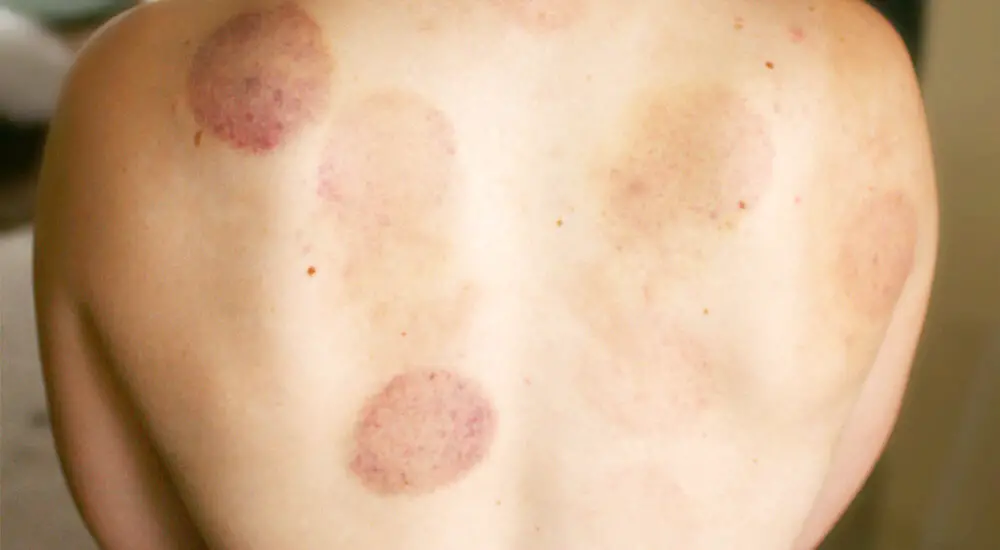It is great to use alternative forms of medicine, such as cupping. But you must also know how to take care of your skin after cupping for the best results.

Table of Contents
Color of Skin After Cupping
Typically, your skin turns different colors immediately after a cupping session. You may see it turn deep red, pink, or even purple. The cups used in the session will leave circular marks on your skin, and it is those marks that change colors. The discolorations on your skin when you undergo cupping will vary, depending on how healthy you are. But the colors will fade with time; some may take a few weeks while others will only take a few hours to disappear.
The reason is that cupping uses suction to loosen and lift waste from your cells, increasing lymph and blood flow. This action affects the deep tissues in your body and may cause symptoms that mimic the flu. However, they are temporary and will resolve with time.
You may also notice blisters or red marks on your skin apart from the cupping marks. These are usually darker than the other marks and look like bruises. They are called cupping blisters but are not painful or harmful. The bruises appear if your body has deep tissue or muscle injury you may not be aware of, and the cupping draws stagnant blood in the injury to the skin’s surface.
How to Treat Skin After Cupping
There is not much to do to the skin after cupping except to protect it from sun rays or other heat sources. Also, keep yourself protected from excessive cold, and do not use high air conditioning. You can take a shower or bath after the session, but consider using only filtered water unless you trust the main water supply. Your skin is pretty sensitive at the time after cupping and is highly susceptible to chemicals.
Furthermore, avoid drinks and foods that contain a lot of sugar. Keep away from processed meat, alcohol, and caffeine. They undermine the effectiveness of the treatment by slowing the body’s capacity to process it. In addition, do not exercise, at least until your skin recovers. You will sweat, and the toxins will re-enter your body and undermine the treatment.
The cupping marks on your skin tend to disappear on their own over time, with little or no help from you. But if you want them to disappear faster, drink a lot of water and rest. Your body needs a lot of water to clear the accumulated waste from your body. That way, the marks, which represent cellular waste, disappear quicker than usual. Resting helps your body recover from the tiredness or aches you may feel after the treatment.
It is crucial to note that everyone responds differently to the treatment. What you experience may not be the same as that of another person. So, speak with the licensed therapist if you have concerns about your skin’s reaction to cupping.
Click here to read these interesting articles…
Skin After Birth [Problems & Remedies]
Skin After Blackhead Removal [Problems, Remedies & Care]
Skin After Botox [Problems, Remedies & Care]
Skin After a C-Section [Problems & Remedies]
Skin After a Biopsy [Problems, Remedies & Care]
Skin Reaction After Cupping – What to Do
Speak with your therapist or doctor if you negatively react to cupping. Some people develop a rash or permanent skin discoloration. Others who already have skin conditions such as psoriasis or eczema discover the conditions become worse after cupping. These skin conditions may experience intense itching. A few have skin infections resulting from the treatment.
It is crucial to learn all you need to know about the treatment before subjecting yourself to it. Not everyone positively responds to it, especially those with pre-existing health conditions. Therefore, arm yourself with the right information.
Why Does Skin Itch After Cupping?
You may find your skin itching after cupping due to renewed blood circulation and drawing stagnant blood to the surface. The itching should stop after several hours, but you can alleviate it with a moisturizer or lotion.
Yellow SKin After Cupping – What It Means
See a doctor immediately you notice your skin turning yellow after cupping. You may have an infection if your skin turns yellow after cupping. The treatment causes different colors on the skin, depending on who undergoes it, but yellow is not one of them. You can verify if there is an infection if there is accompanying pain, swelling, chills, and fever.
Recap
Cupping is acclaimed to be one of the best ways to treat certain health conditions. It is good for anyone unless you have a pre-existing condition or are pregnant. But you must also learn how to take care of your skin after cupping, especially because of the marks and discoloration. Fortunately, this article lists the simple ways to achieve the best care.

